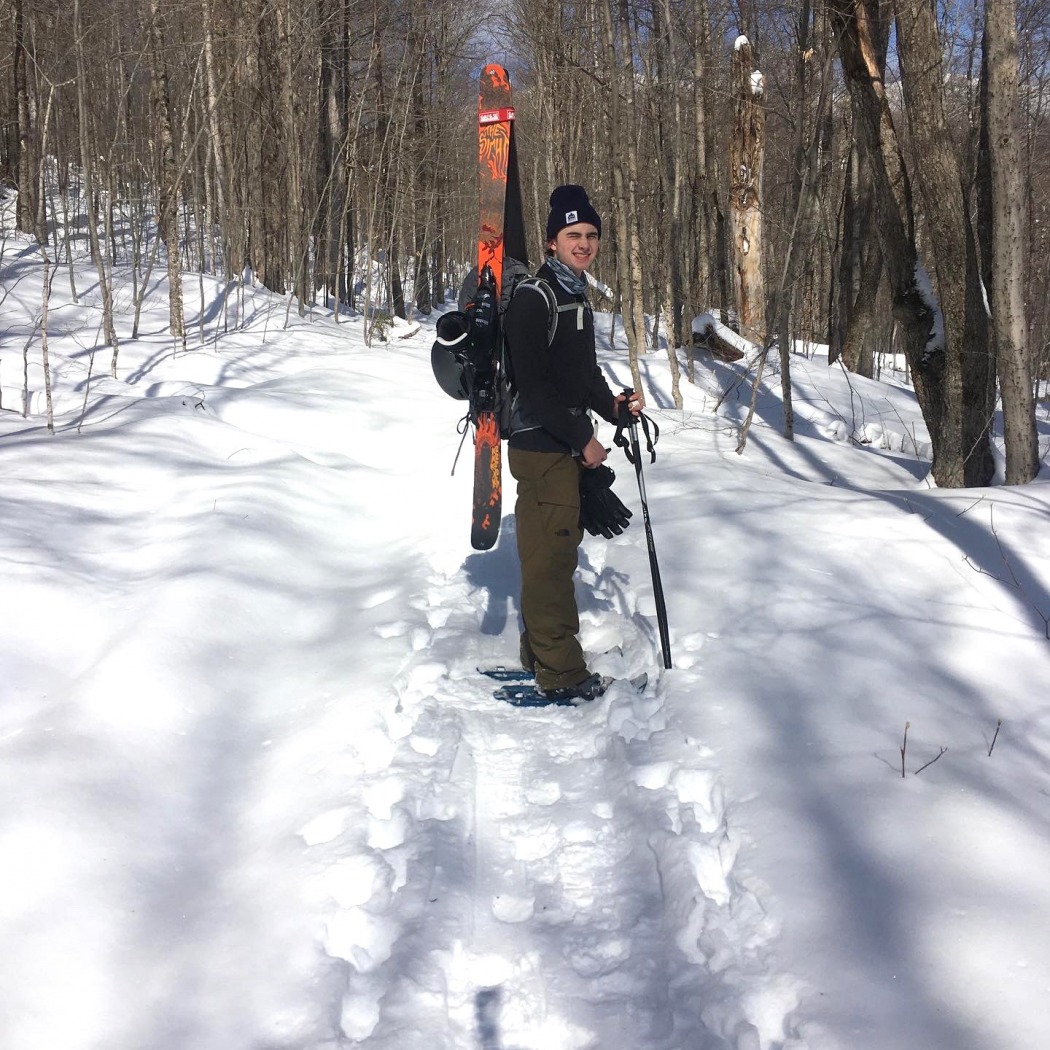
The author with his ultralight setup early in the day as he takes his initial steps towards becoming backcountry. Photo: Keaden Morisaki.
Sparks flew and smoke shot up from the truck’s engine, intersecting alarmingly with John Peck’s cigarette. John was an older man I’d met ten minutes before when another stranger whose name I never got dropped me off on the side of the road.
It was a frigid morning in Warren, New Hampshire—the kind where the near greaseless doors of your two-wheel-drive sedan squeak for help. After a curt “how are you,” and “good, n’you,” I told my story to John. My friend and I had buried our rented Kia Forte in a snowy ditch two miles down Breezy Point Road. We couldn’t dig it out, we had no cell service, and we definitely didn’t want to call my parents for help.
While John tried to remember whether the red clamp connected to the positive or negative terminal on his truck’s battery, I thought about what posers we were.
***
Backcountry skiing is inherently inaccessible. A beginner setup can cost upwards of $2,000, and that’s without layers, safety gear, and avalanche education. The entry fees add up, not to mention the traveling fee for the majority of us who live far from couloir-striped cirques and 30° meadows. Stashes are few and far between.
It’s also hard to garner experience. Not all of us are born into families whose ancestors were making tele turns into fresh powder in the ‘80s. Not all of us went on heli-skiing trips for Christmas. Not all of us took a year off to sample NOLS’ finest trips into the Teton Valley or the Winds and found mentors en route.
But in February of 2020, my friend Keaden Morisaki and I were kooks with unbridled enthusiasm who would do anything to gain experience. After watching one too many Fifty Project videos during a bad snow year at our Boston college, we decided to head to NH to try backcountry skiing. We rented a Zipcar, grabbed some snowshoes from my outing club, and set out to carry our heavy downhill skis up the five mile Carriage Road on Mt. Moosilauke.
Mt. Moosilauke stands at 4,802 feet. To Keaden, who grew up in Flathead, Montana, it was a hill. To me, however, who had grown up just southwest of the White Mountains in Grantham, NH, Moosilauke was burly, or whatever I thought that word meant as I shape-shifted what I gleaned in TGR films to my local hills.
The idea of climbing and skiing the Carriage Road was inspired by a trip report I read from Eastern Mountain Sports. They made my favorite fleece, so I figured their descriptions of the trail as being “never exceedingly steep” and having “plenty of room for making turns” were trustworthy. We couldn’t find any history of avalanches and thought the risk of injury would be low, but we still threw some shovels in our bags just in case we fell into a tree well. Another potential danger we’d read about online.
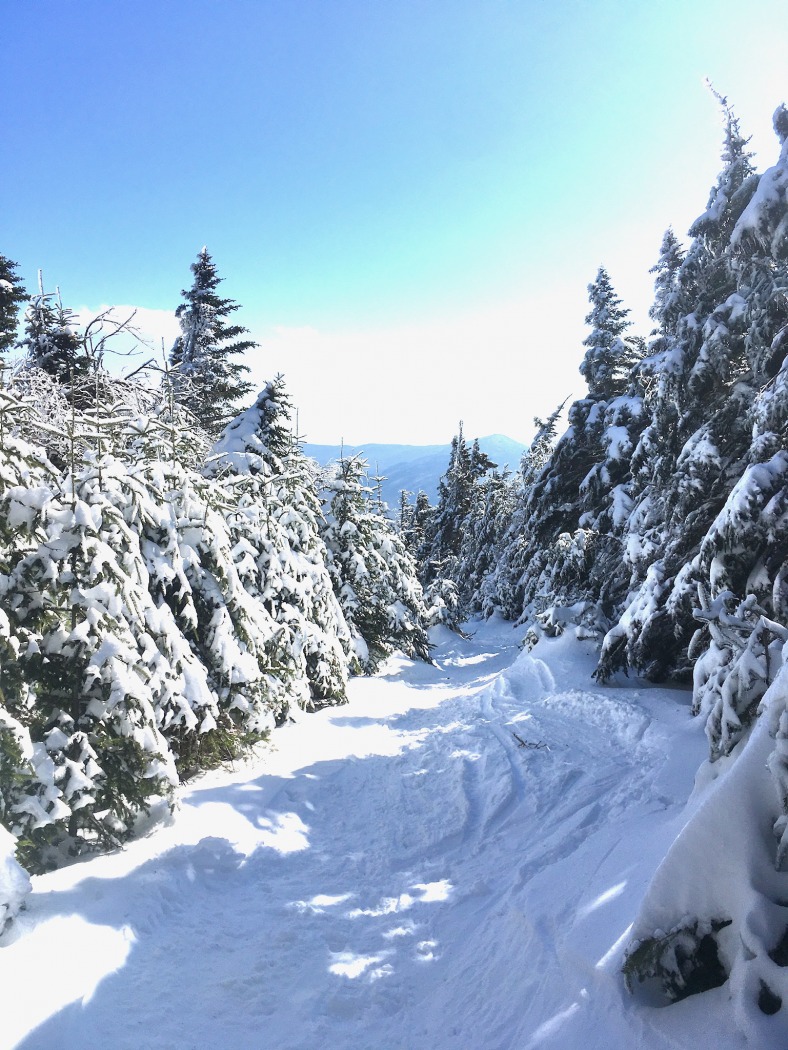
The best part of the anticipated trail. Not bad air on the right and make sure you are capable of tight turns. Photo: Keaden Morisaki.
Preparations complete, we set our alarms for 4:30 a.m. and pretended to sleep for six hours. The next morning we put on our leather hiking boots, shouldered our 40-pound backpacks, and left our dorm to find the car we’d rented.
The first challenge was near immediate; we spent 20 minutes trying to figure out how the Kia’s middle seat folds over. How many liberal arts students does it take to understand car mechanics?
After that low hurdle technical problem, we cracked Red Bulls, beginning our taurine-fueled journey. I pulled out a borrowed GoPro and framed cinematic shots of driving over Bunker Hill Memorial Bridge and more wide shots of farmlands and shots of the woods just before the trailhead. Our aspirations went beyond the backcountry and dreamily pivoted towards documenting everything for our potential Youtube followers.
“That’s a sick shot!” “Oh my gosh, we’re really doing it!”
I said those things.
The moment came shattering to the ground when Keaden misjudged our car’s front-wheel-drive abilities and sent it glissading into a small ditch 100 feet from the trailhead.
We laughed, trying to ease the severity of the situation: “Well, at least we brought those shovels, right?”
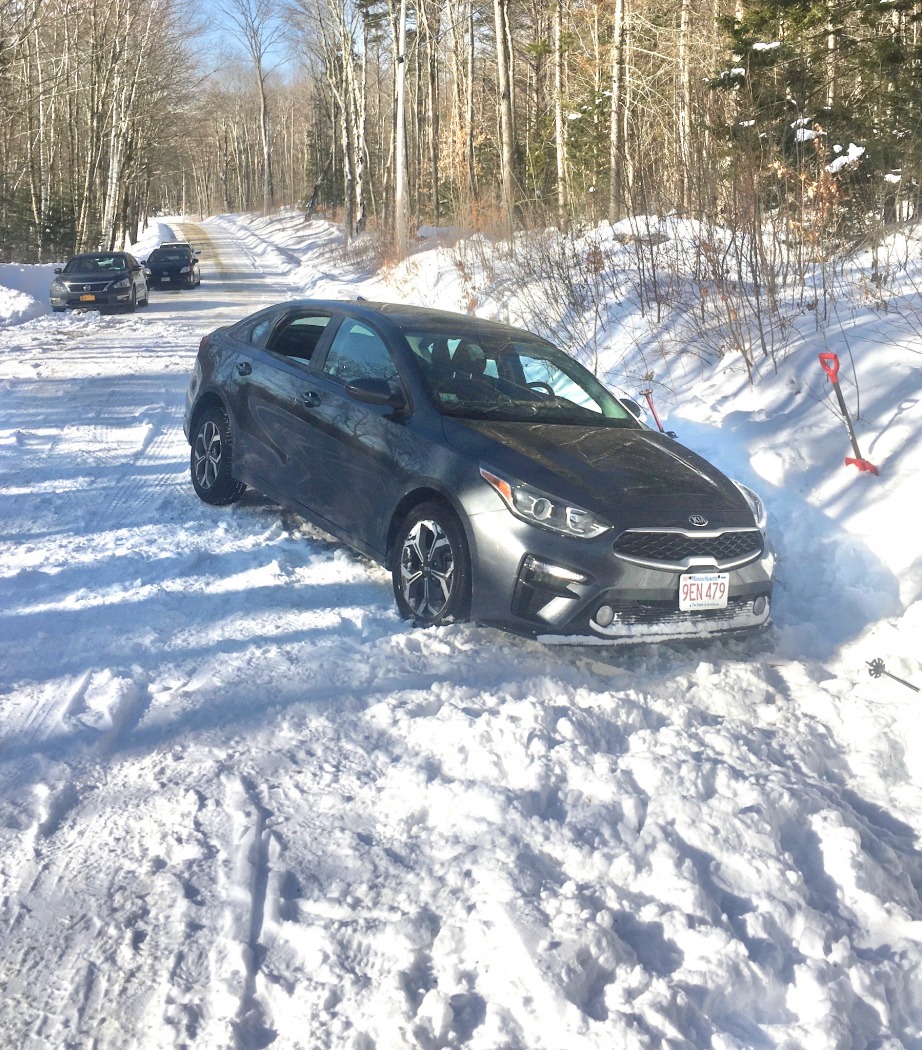
The rented Kia Forte, getting pitted in a ditch. Note the borrowed shovels set in the snowbank. Photo: Keaden Morisaki.
The next two and half hours followed a similar pattern: shovel, put floor mats under tires, and gun it. We made what seemed to be progress moving the car down the ditch. One seasoned skier who arrived after lent his hand shoveling.
But as the story goes, there’s a moment where one realizes it’s a lost cause. Keaden gunned it one last time while the unknown skier and I pushed. A new layer of snow gave way and clogged the wheel wells, burying the bottom of the car to the nth degree. I turned to the unknown skier and asked for a lift to find cell service.
***
We ride fine lines as beginners. In a perfect world, the first time trying something involves some mild embarrassment, coupled with some light falls, all, hopefully, in a safe environment. The consequences aren’t cataclysmic.
Backcountry skiing is a bit different. Most beginners have skied before. They have the requisite physical skill and reasonable expectations of their actions. The tricky part is critical thinking and decision-making. How does the snowpack look and feel? What’s the weather going to be doing in the afternoon? What food should we bring now that resort chicken tenders are out of the question?
Riding in the passenger seat of a stranger’s Outback, I felt like I’d messed up every decision. I had told Keaden to keep driving despite the suspect driving conditions, I chose the place we were going to ski, and I only packed us ten Luna Bars for the day because my friend, who was the on-campus representative, got them for free. It was my fault.
And because it was my fault, I knew I had to get us out of it. Hopping a stranger’s car was another suspect decision, but it was the only option. The next part, however, was a stroke of beginner’s luck.
As we joined the main road, still without service, I spotted a man sitting on his porch smoking a cigarette with a phone on the table next to him. I looked in his yard, and I saw a big truck and a plow off to the side. Having grown up in New Hampshire, I knew that the majority of our residents are resourceful people, especially the ones with plows.
I told the stranger to pull over and let me out. What followed was a series of phone calls to a “buddy down the street” who had chains, a sketchily jump-started truck, and a passenger seat full of empty Natty Lights. John Peck and his friend drove me back to the trailhead, thundering down the road towards a confused Keaden standing next to the submerged Kia. We attached the chains, pulled the car out, and thanked our saviors. John delivered a quick fix, free of charge. I got his P.O. Box, determined to send him a six-pack of beer at a later date.
This was the luck we’d been missing. All of a sudden I felt better about being a beginner. We were back at a new square one, one closer to our objective than where we had started at 6:30 that morning. Our enthusiasm was restored and we set out to catch the skiers ahead who had passed us without offering help.
***
Exhaustion in resort skiing is predictable. Bouncing from mogul to mogul wears down skiers’ quads, and a day in ski boots tires out the calves. Nothing a rest on the chairlift ride back up can’t fix.
Backcountry skiing was totally different. And mind you, we didn’t know the cultural norms, best practices, or any skin track etiquette. From the moment we started snowshoeing over the skin track up the trail, my hip flexors were burning. Carrying resort skis and boots on our backs was an unsustainable form of travel, but a necessary condition for our newby selves. We took breaks often and good-naturedly complained about how hard this new activity was.
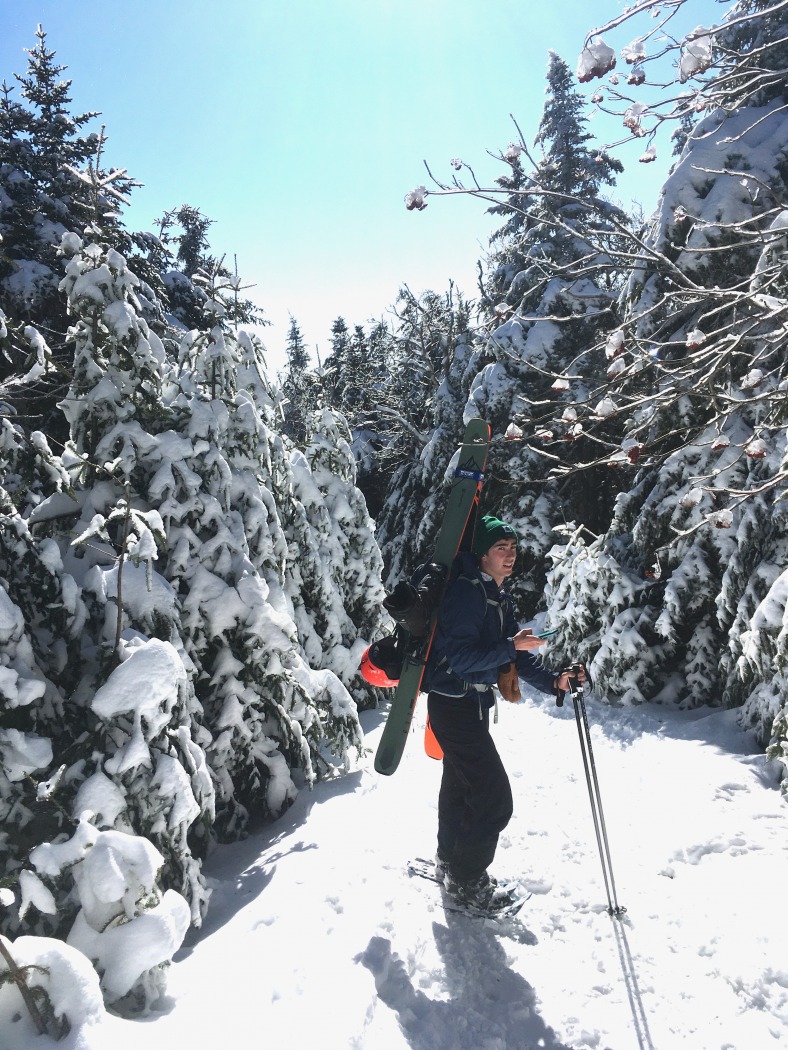
Keaden Morisaki higher up on the trail checking how much further he has to suffer the East Coast. Photo: Ethan Daly.
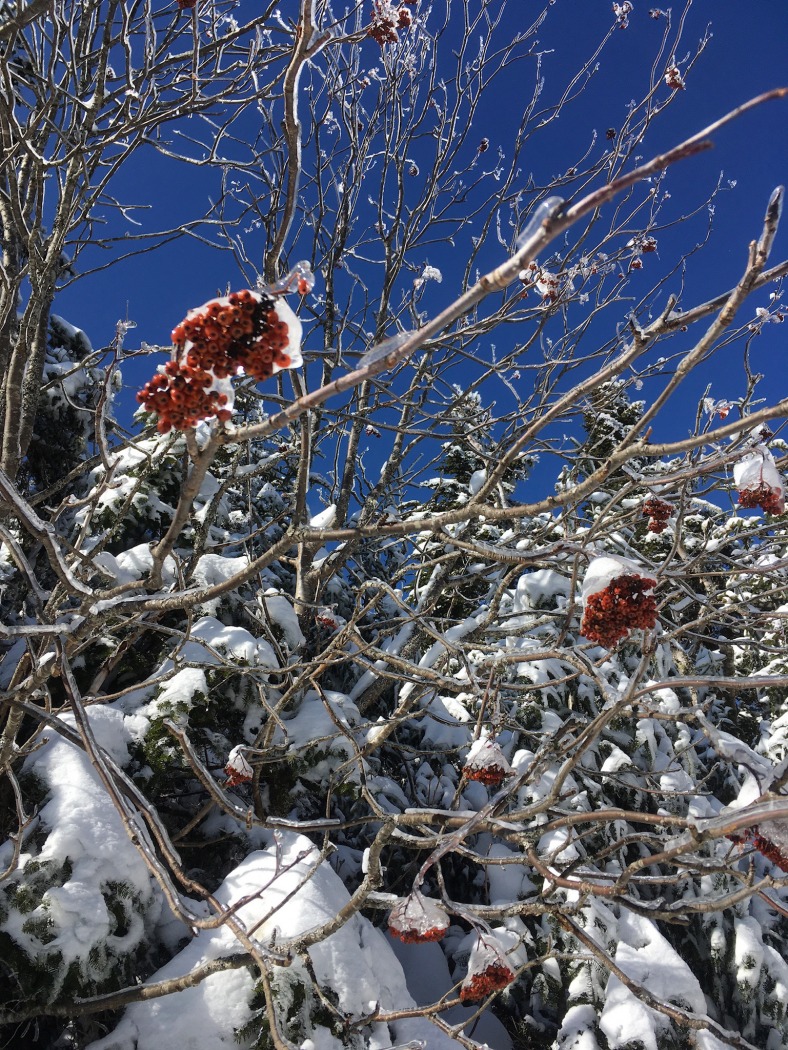
A beautiful interlude of snow-covered clusters of Mountain Ash berries. Not a tree that indicates good glade skiing. Photo: Keaden Morisaki.
We pressed on, unaware of how soreness on the uphill would translate to our quality of skiing on the downhill. Any notions of passing the skiers who hadn’t helped us shovel were futile. They came down the trail, gliding right past us, helpfully asking, “did you get the car out?”
We hiked late into the afternoon and about four and a half miles in, we stopped short. Some higher level of thought interfered with my beginner’s brain and told me, “don’t push for the summit; you’re gassed.” A half-mile short of our objective, Keaden and I decided to begin our transition to the downhill.
We took off our snowshoes, haphazardly hung them from our packs, and stepped into our ski boots. I produced a Hawaiian shirt from my bag and threw it on over my more technical jacket. I once heard splitboarder Jeremy Jones say, “you can’t have a bad time in a Hawaiian shirt,” and knew I would need it for the way down.
Keaden led the way on a pair of Salomon QST 106s, a ski fit more for Whitefish than a scratchy Eastern hiking trail. He immediately fell into a tree and called back up, “dude, this is narrow.”
I stepped into the downhill on my pair of K2 Sights, a twin tip park ski I’d bought discounted in the fall. I also skied straight for a brief five seconds, lost a ski on a tree, and yard-saled.
As eager as I was to capture good skiing on the chest-mounted GoPro, we’d have to ski ugly to ski safe. Keaden and I fired up the oven and pizza’d most of the way down Moosilauke.
After stumbling down the mountain, we arrived at our car, still sitting free of the ditch. We changed into dry clothes, each drank another Red Bull, and carefully navigated Breezy Point Road to drive home. Our legs were spent and we felt lucky to not be waiting for a tow truck.
***
A few days later, I sifted through the GoPro footage on my computer. It was awful. The footage confirmed the ski ugly axiom we adopted; our skis were pointed inwards for 90 percent of the ski down. Any edit I hoped to produce would be marred by our miserable skiing. I wasn’t the next Cody Townsend.
Our memory of the trip became something better, though. Around campfires and dinner tables in the years after, we remember the trip fondly. Our memory of Type III fun gave way to Type II and then Type I. All the anxiety and imposter syndrome we experienced that day had been worth it for a good story and dreams realized.
That’s the essence of being a beginner in the outdoors, specifically backcountry skiing. It’s expensive, messy, and unproductive in the grand scheme of things. It’s an inherently laughable activity—hiking uphill for hours just to ski back down in a fraction of the time.
And yet, it’s the fastest growing portion of the ski industry. Plenty more skiers are going to snowshoe a skintrack and wear insulated snow pants on their first day out. Plenty more are going to ask for your hand shoveling their car out, all in the name of gaining experience at whatever cost.
And that’s okay—we’ve all been there. Wherever I’m skiing from here on out, I’ll try to have chains in my car and some food better than Luna Bars in my backpack. Hopefully, I’ll have a better touring setup and stronger hips.
I do know that I’ll be there in the parking lot, spreading love for the sport and pulling cars out of ditches so that everyone can smile at the ten percent of their footage where their skis are parallel, leaning quickly into a patch of fresh snow, with birch trees zooming by in the foreground.
Ethan Daly is originally from Grantham, New Hampshire. A recent graduate from Boston College, where he studied Environmental Studies and Spanish, he’s done a 180 and is looking for jobs in journalism. Currently, he’s working for the Appalachian Mountain Club in their huts system, continuing to perfect his mediocrity in outdoor sports.

